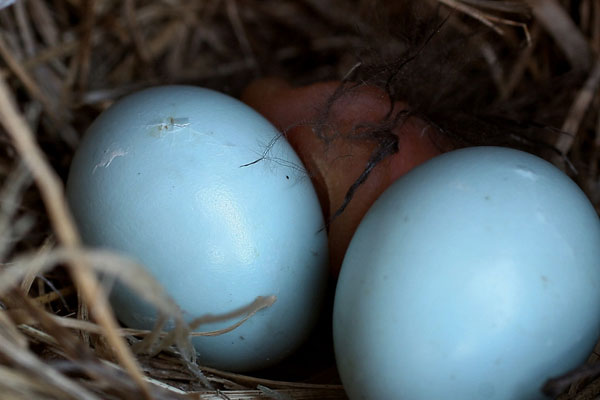ANSWER: Shortly before hatching, the embryo taps into an air bubble inside the egg.

The embryo inside an egg shell begins to breathe a few days before hatching. Soon after an egg is laid, a small air bubble forms in the large end of the egg, underneath the shell. A membrane separates the mass of the egg from the air bubble. The egg shell is porous, and contains a small air bubble.
Just before starting to breathe, the embryo develops an egg tooth, which is a small, hard calcium spike on the top of its bill. The egg tooth is used to pierce the membrane that separates the chick from the air bubble. This hole is called the “internal pip.”
The air provides the chick with energy, and then it breaks through the shell to the outside world. This step is called the “external pip” It can take between 12 and 48 hours for the chick to break through the shell and extricate itself.
During that time, it is absorbing the yolk sac and fully inflating its lungs. The chick is usually exhausted by this process. Because it gets nourishment from the yolk sac, it does not need to eat for several hours, giving it time to rest and dry off. [Thanks to Amy Ries for this description.]
Problems can occur – see Why didn’t the eggs hatch? For example, if the small end of the egg is persistently higher than the large end (where the air bubble is), the embryo can “drown” during pipping.
More information:
- Egg production
- How Many Eggs Will a Female Lay?
- Why didn’t the eggs hatch?
- Weird eggs (various species)
- Egg sizes (comparison table) for various small cavity nesters
- Nest and Egg Identification (photos and descriptions)
- Newborn bluebird photo
- Eggbound female
- Photo of blood smears on eggshell
- Supplementing Calcium – Feeding Chicken Eggshells, etc. to Birds
- I found an egg – can I hatch it?
- How does a bird embryo breathe inside the egg?
It may be hard for an egg to turn into a bird: it would be a jolly sight harder for it to learn to fly while remaining an egg. We are like eggs at present. And you cannot go on indefinitely being just an ordinary, decent egg. We must be hatched or go bad.
– C.S. Lewis
